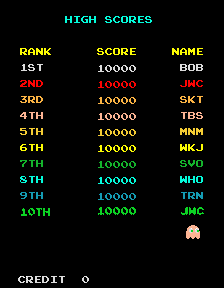There doesn’t seem to be much available out there about Social Media from a gamification perspective that is accessible to regular users as opposed to designers or math-types.
Gamification is the use of game play mechanics for non-game applications, particularly consumer-oriented web and mobile sites, in order to encourage people to adopt the applications. It also strives to encourage users to engage in desired behaviors in connection with the applications.
As such, I thought I would give it a brief treatment that will (hopefully) be accessible to most people. It should demonstrate why lawyers, or anyone really, are easily seduced by Social Media and readily engage in the activity without really understating:
- why they are doing it
- what they feel they are getting out of it.
It’s been designed that way.
Why People Fall Prey to the Allure of Social Media
Older Readers might remember the heydays of video game arcades, in which people would compete for rankings on a High Score Leaderboard in Pac-Man, Galaga, Street Fighter, and the like.

Whether players realized it at the time or not, a high score leader board was designed, not to display who was best at playing the game, but to encourage players to keep putting quarters in the machine.
By having a visible history of the best players, it encouraged people to continue to play the game (put more quarters in) in order to try and earn a spot on the leaderboard. It is a classic display of manipulating the ego of the user in order to drive them into further interaction with the system.
In recent years, this process has become known as “gamification.”
Gamification works by making technology more engaging, and by encouraging desired behaviors, taking advantage of humans’ psychological predisposition to engage in gaming.
Early examples of gamification are based on rewarding points to people who share experiences on location-based platforms such as Facebook’s “Place” feature, Foursquare (social network), and Gowalla. Some of the techniques include:
- achievement “badges”
- achievement levels
- “leader boards”
- a progress bar or other visual meter to indicate how close people are to completing a task a company is trying to encourage, such as completing a social networking profile or earning a frequent shopper loyalty award.
- virtual currency
Many people will immediately think of online gaming; Farmville, WoW, and the like. But it goes beyond that.
Q: Why do people care so much about something that has little to no effect on their real life?
A: Because their stats are constantly shared with themselves and their peers and it becomes a status symbol or competition of sorts.
However, this isn’t just limited to gamers…too much of people’s time is consumed with checking email because…they have unread email messages. They check their to-dos and task lists. They spend time on RSS feed or making sure that they get upvotes on Reddit.
Much of people’s online life is trying to suck them in even further with engagement stats and feedback loops: Twitter followers, RTs, DMs, @ replies and lists; Facebook friends; Netflix Queue lists and rated movie counts…
Engagement Statistics and Positive Feedback Loops
The true shining example of a social media service exploiting gamification to its fullest is Twitter. While there is no formal leader board or badges or achievement system; it doesn’t take new users long to become keenly aware of their number of “Followers,” @replies, “Re-Tweets,” and Lists (“engagement statistics”).
By having its users engagement statistics publicly available, Twitter subtlety enables users to enter into a feedback loop with the service. Twitter does not separate out its gamification through leader boards or badges, rather, gamification is baked into the system itself.
Merely using Twitter may result in a user engaging in a self-perpetuating “game” / positive feedback loop. To help explain the concept for people unfamiliar with feedback loops, an illustration might be in order:
Image Courtesy of Lost Garden
Player Action (User Action)
1)Player Action: A user sends out a Tweet (or Re-Tweets another users Tweet).
Simulation (System)
2a) BlackBox: This is the Twitter backend system.
2b) The Tweet is now in the System (a Token), wherein other users may either ignore, Re-Tweet, or reply directly to the user (State Change).
Synthesis and Filtering
3a) Feedback: The Twitter system communicates any state change back to the user.
3b) Useful/Useless info:
1) The Tweet is ignored by all of the users followers and generates no Re-Tweets of replies. This is Twitter’s only type of negative feedback. While quite mild, it probably does modify the users behavior. Users should learn what does and does not elicit a response from their followers. Which in turn may direct the user to alter their future Tweets in order to generate the most responses from their followers.
2) The Tweet is Re-Tweeted by followers. This is the base level of positive feedback. The user gains the satisfaction that they have provided information that is found to be worthwhile.
3) The user receives a direct @reply to their Tweet. This is the middle level level of positive feedback. The user’s Tweet elicited direct feedback and communication from a follower.
3c) Tools: New followers. The most powerful feedback Twitter can offer it’s users. When a user receives a new follower after a Tweet, it means that they have broadcasted information that a total stranger found compelling enough to follow the user’s future tweets. Thus giving the user a larger audience in which to broadcast information.
As such, the feeling of appreciation and sense of contribution generated from positive feedback, or the feeling of neglect from no feedback both feed directly into the user’s next action in the system.
Manipulating the User
The Twitter system encourages following, re-tweeting and the like because it functions as a scoring system for the ego of the user. So it’s really no surprise that Twitter generally devolves into cliques and camps – it’s innate to the functioning of the system.
Users encourage other users as part of the positive feedback loop in order to increase their own engagement statistics and push up their number of Re-Tweets, followers, etc. – despite that nothing is actually being accomplished, it generates a feeling of accomplishment.
There is a sense that the user is achieving goals merely by gaining followers on Twitter or generating Retweets. There is no actual, tangible benefit for most users, however, it’s merely a system that has been developed to:
- Gain market share and attention through a feedback loop generated through gamification &
- Push advertising.
It’s great for corporations, advertisers, and savvy entrepreneurs – but poses ethical and sociological issues for its average users:
There’s no wonder corporations are so excited about turning the world into a game. One of the movement’s central insights is that a sense of accomplishment sometimes feels more meaningful than a paycheck…
At a Google Tech Talk last year, Zichermann gushed about the low-cost opportunities this creates for business. He was particularly excited by Zynga’s collaboration with 7-Eleven, a deal in which people could buy FarmVille credits along with a Slurpee. FarmVille credits didn’t get you the Slurpee, Zichermann explained excitedly. Rather, customers paid real dollars for the virtual currency. “It’s all money in and no money out!” he cried.
Being Played
That’s a very broad, generalized overview that I hope will shed some light to others about the underlying structure of the Twitter system.
If it generates some real discussion about the use of Twitter – even better. This isn’t to say Twitter is all bad, but considering the length of this article, I think I’ll put those up on the shelf and return to them at a later date.
The real question is whether you are getting legitimate use out of Twitter or are you just being played? You might want to look at Dan Harris’ answer over at the China Law Blog.
Update: Chris from WestLegal EduCenter just sent me a link to a TED talk on “Game Layers” which dovetails nicely with my post.















